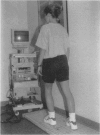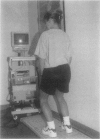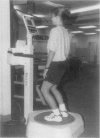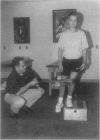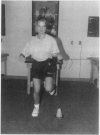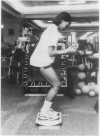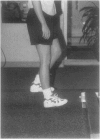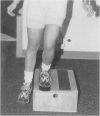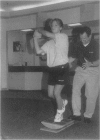Abstract
Objective:
To discuss the rehabilitation program after anterior cruciate ligament (ACL) reconstruction in the female athlete. In addition, we will discuss 8 unique characteristics identified in the female athlete and specific training drills to address and correct the potentially deleterious effects of these unique characteristics.
Background:
The female athlete appears to be more susceptible to noncontact ACL injuries than the male athlete. There seem to be many differences between the female and male athlete that may contribute to the increased injury rate in the female athlete. These variations include anatomical and neuromuscular considerations and differences.
Description:
Based on the unique characteristics of the female athlete and the anatomical and neuromuscular dissimilarities, a specially designed rehabilitation program has been established for the female athlete after ACL surgery.
Clinical Advantages:
The rehabilitation drills discussed in this article challenge the neuromuscular system through proprioception, kinesthesia, dynamic joint stability, neuromuscular control, and perturbation training activities. Improving the female athlete's neuromuscular system will, we believe, expedite the injured athlete's recovery after ACL injury or surgery. Although the concepts discussed are part of a postoperative rehabilitation program after ACL surgery, these concepts may also be implemented as a preventive program to assist in reducing the incidence of ACL injuries in the female athlete.
Keywords: neuromuscular control, perturbation training, dynamic stability
Full text
PDF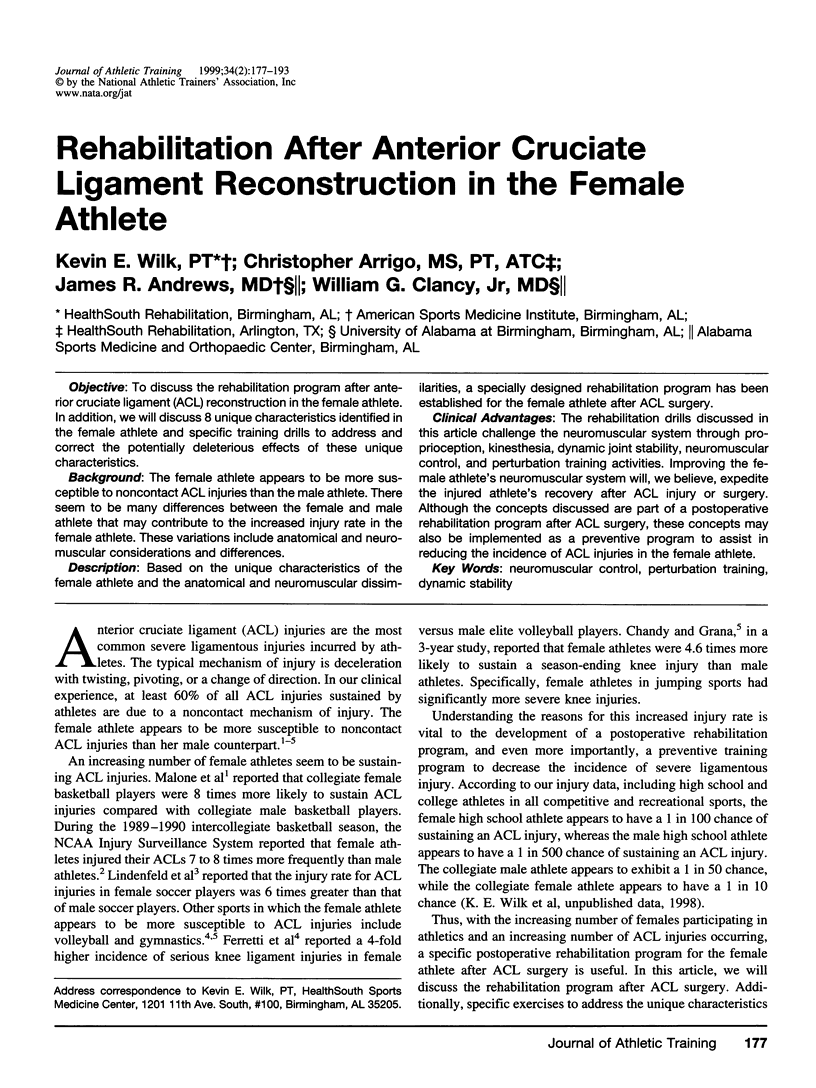
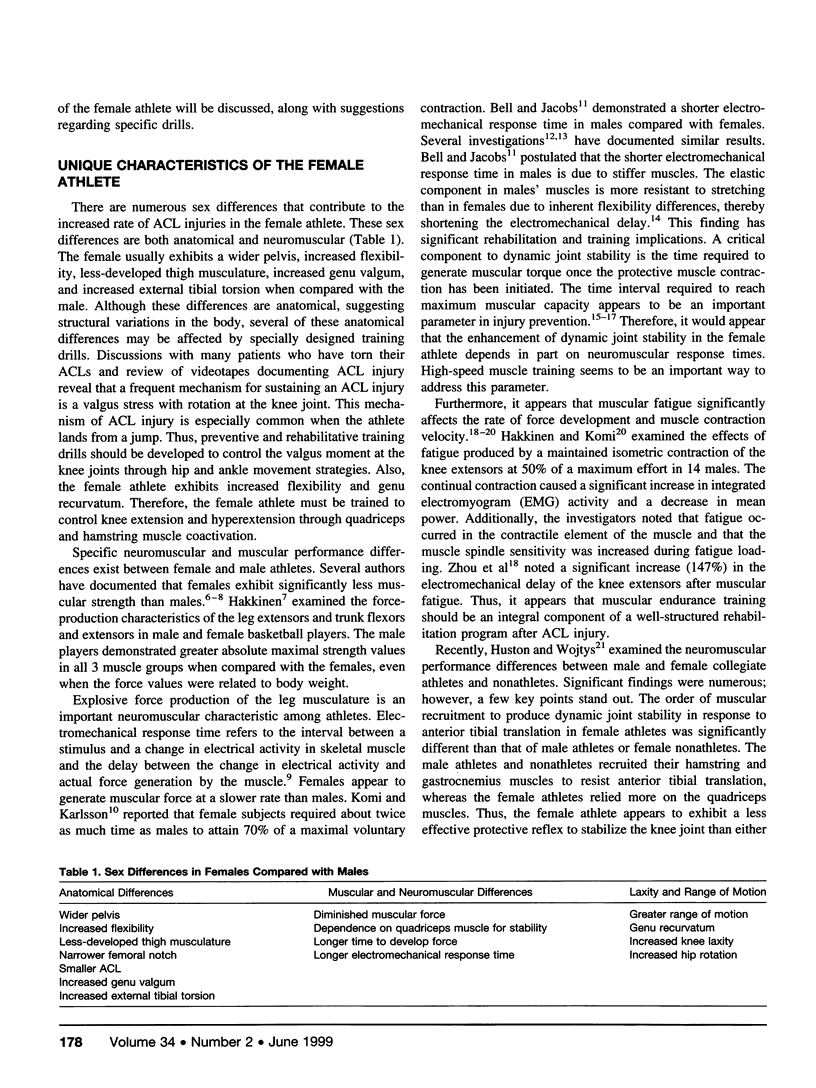
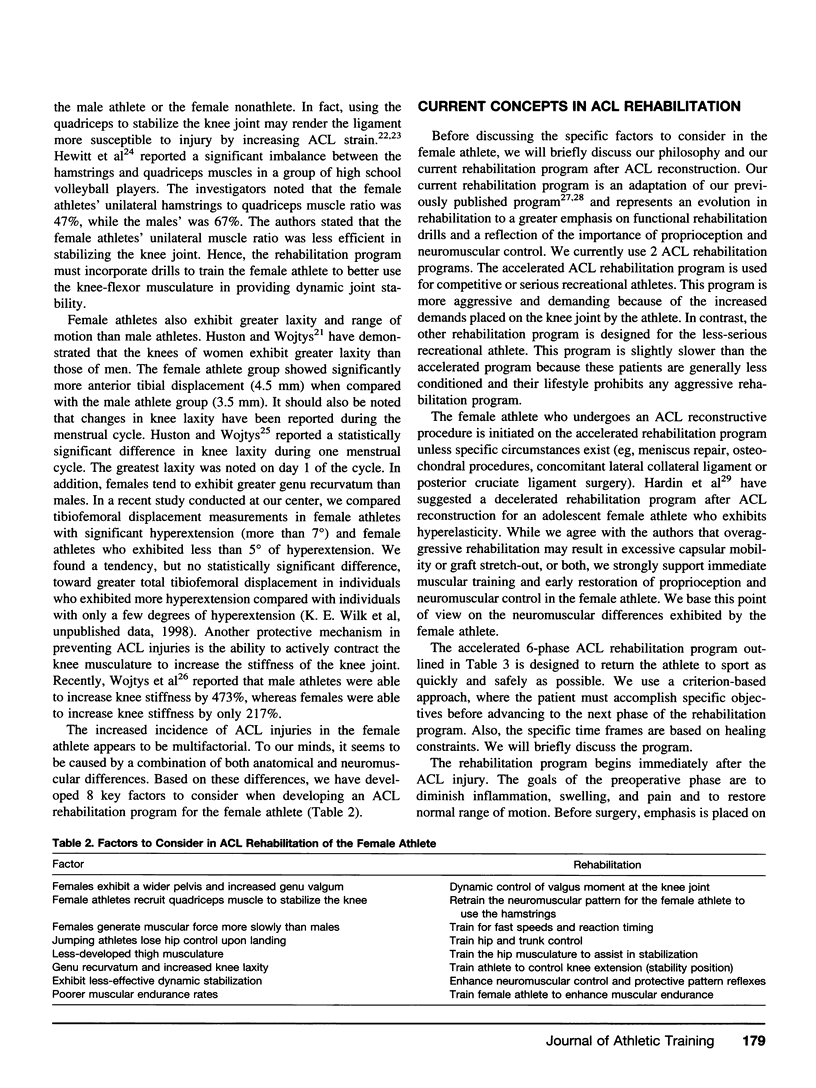
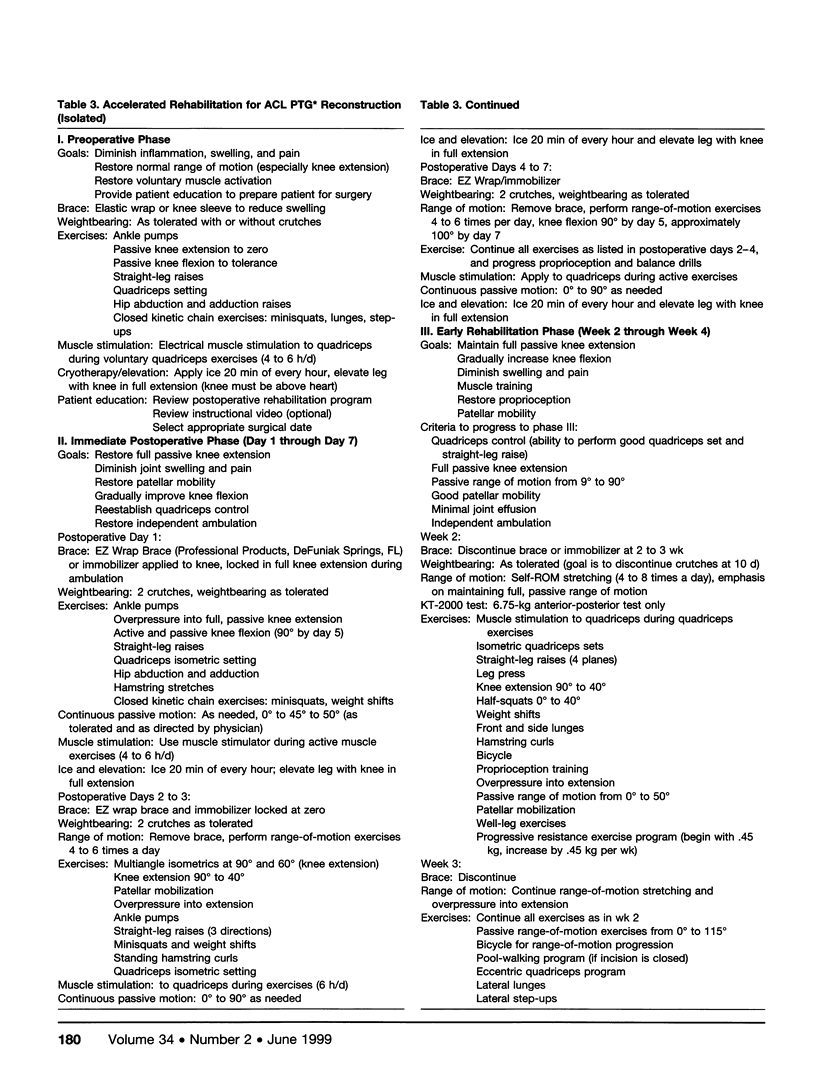
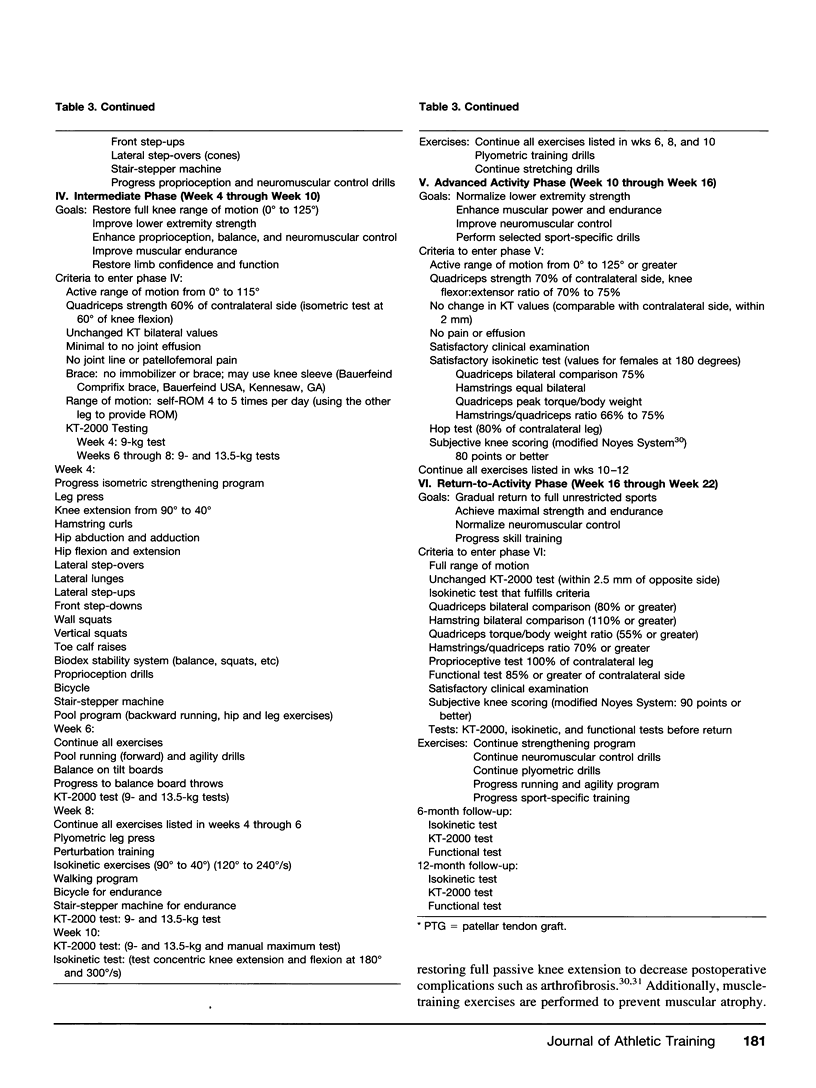
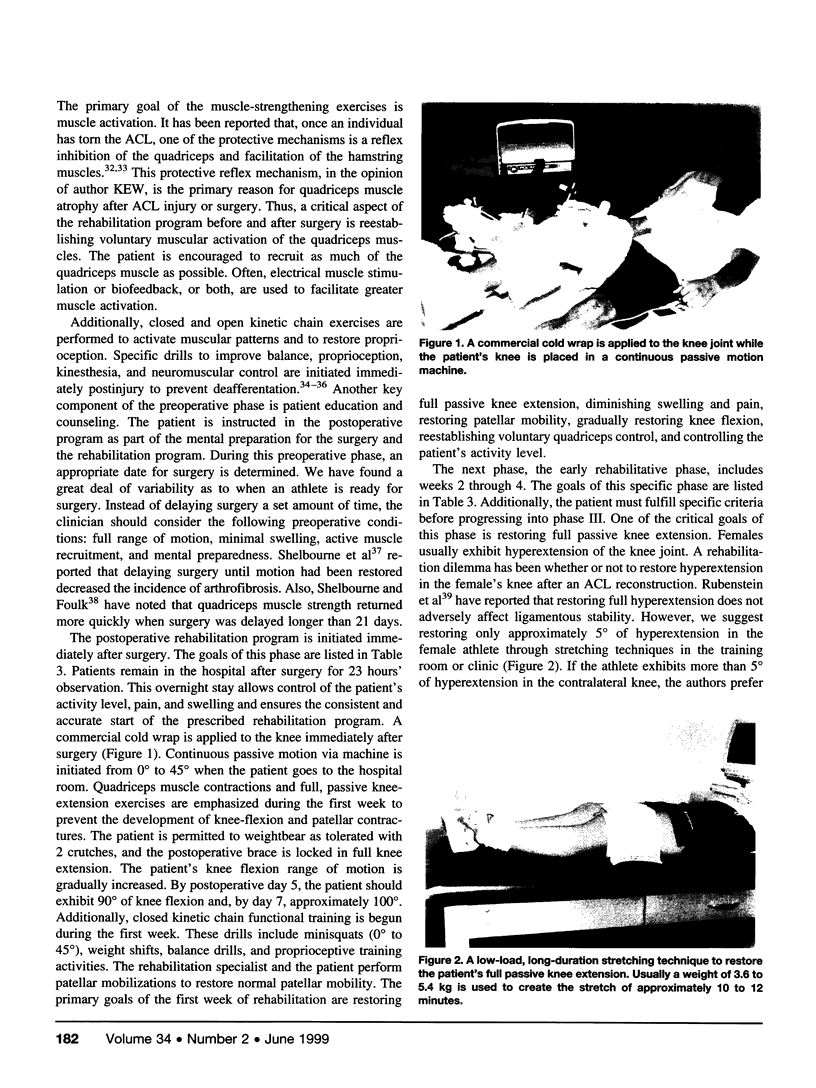
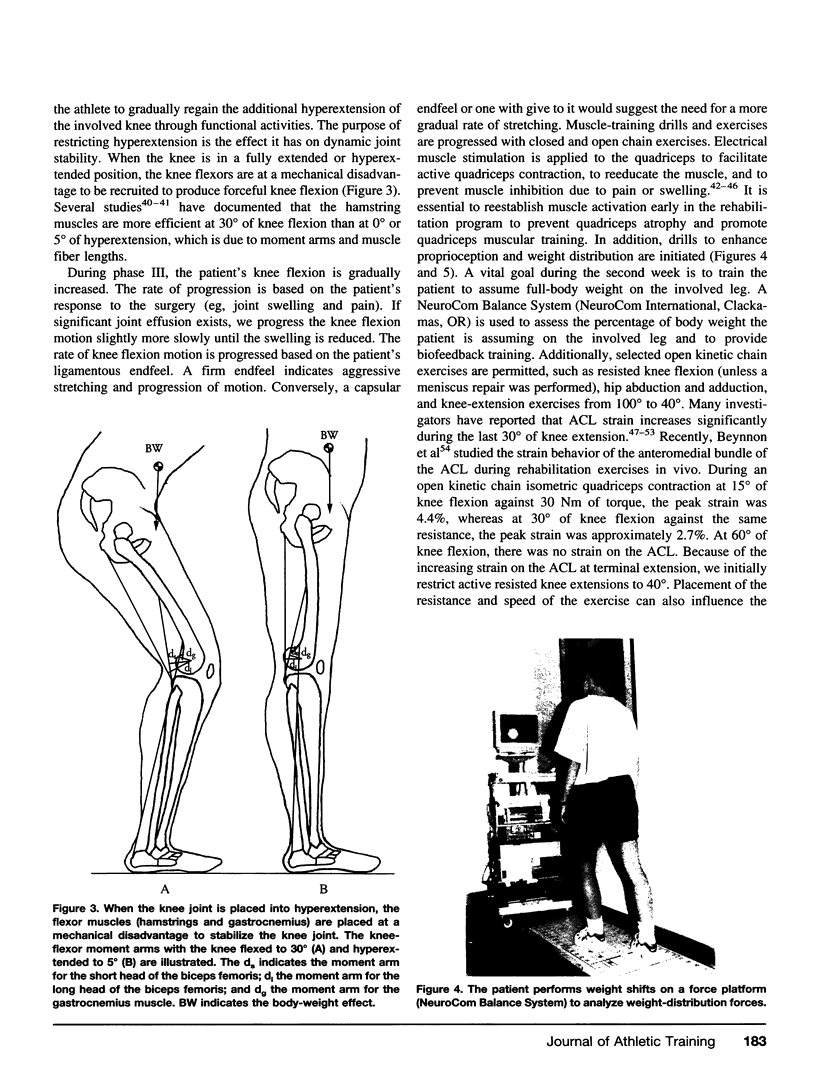
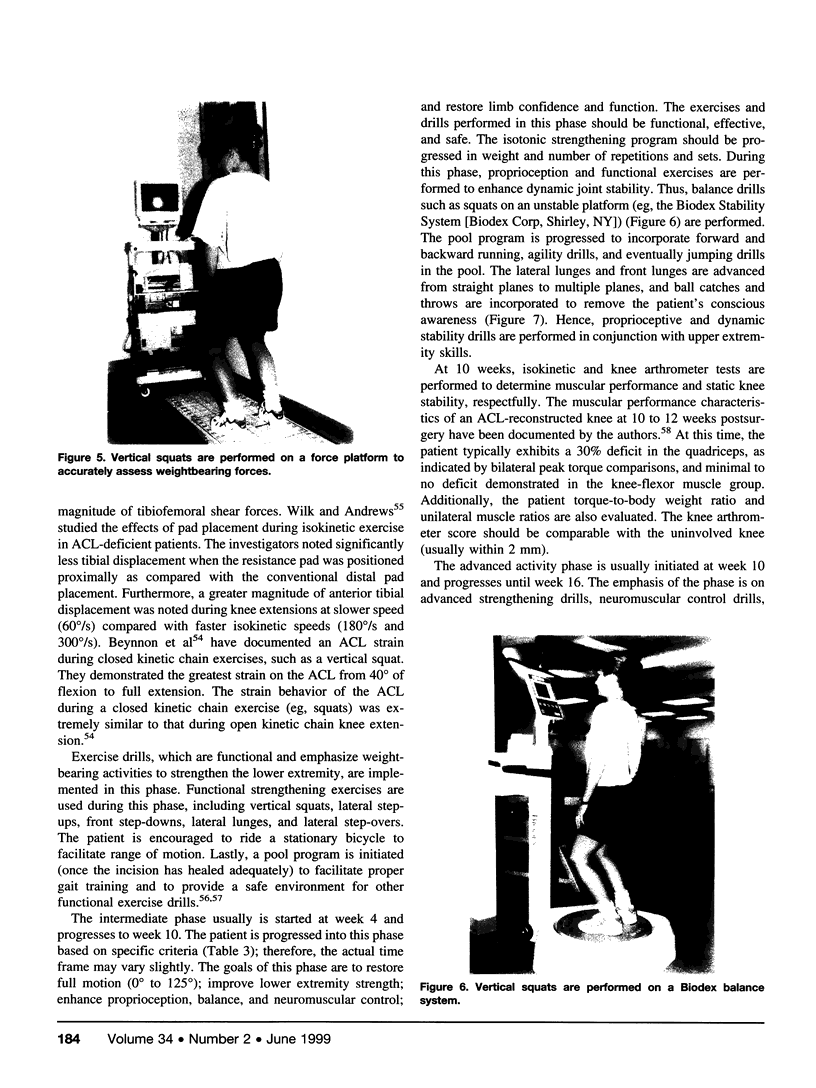
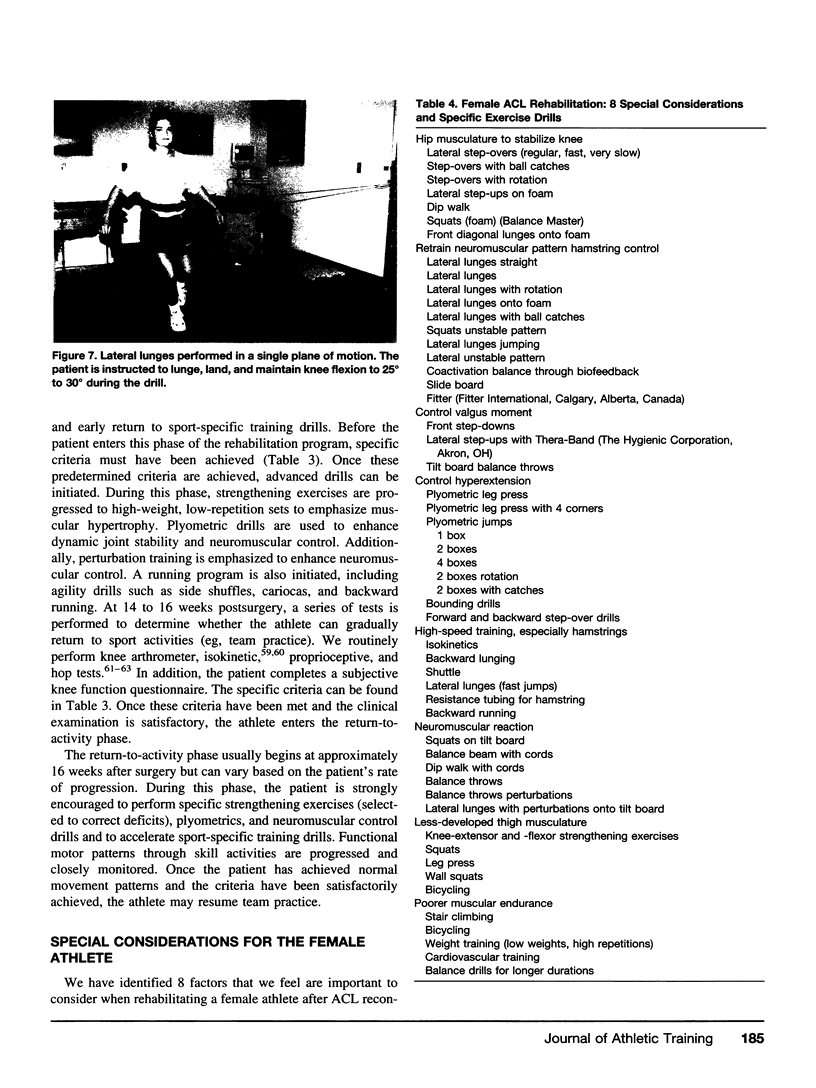
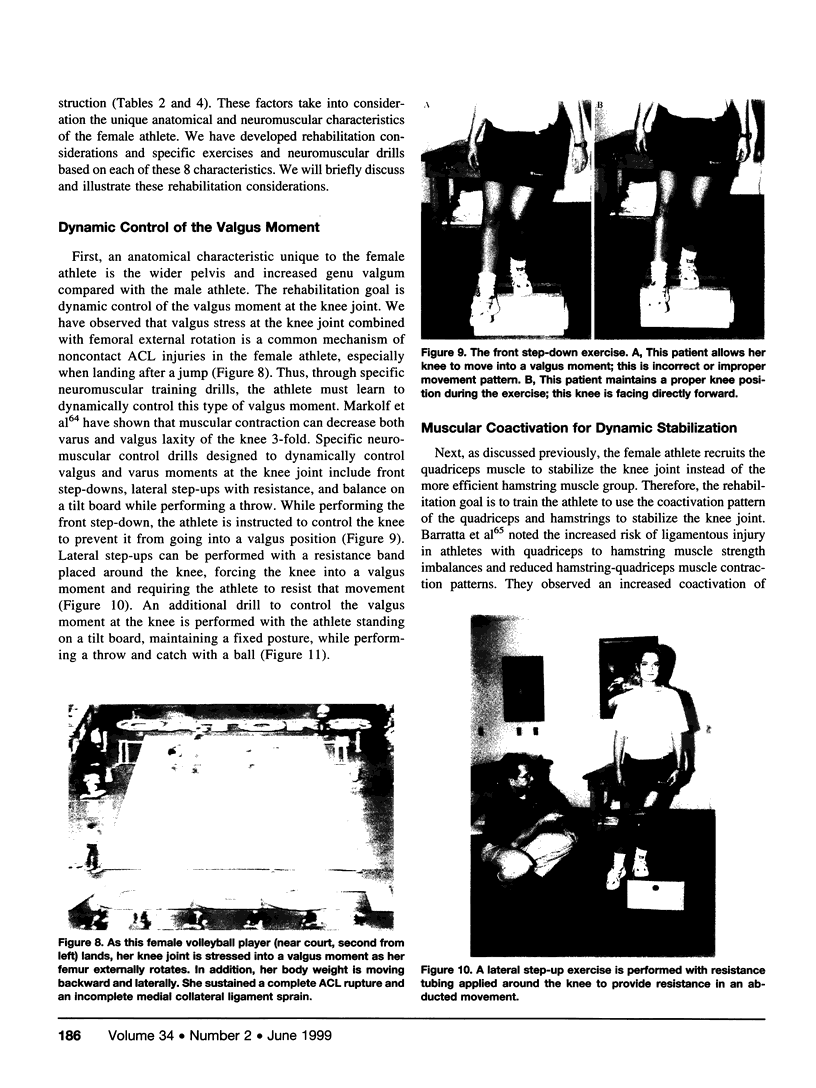
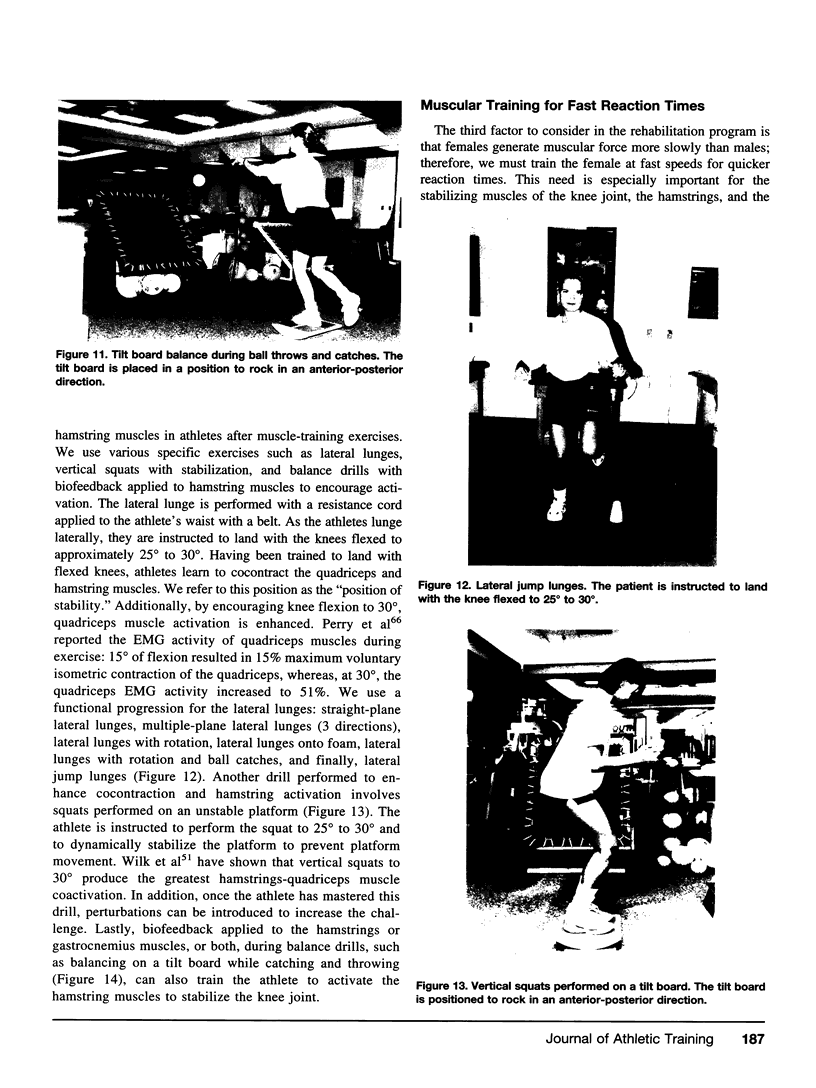
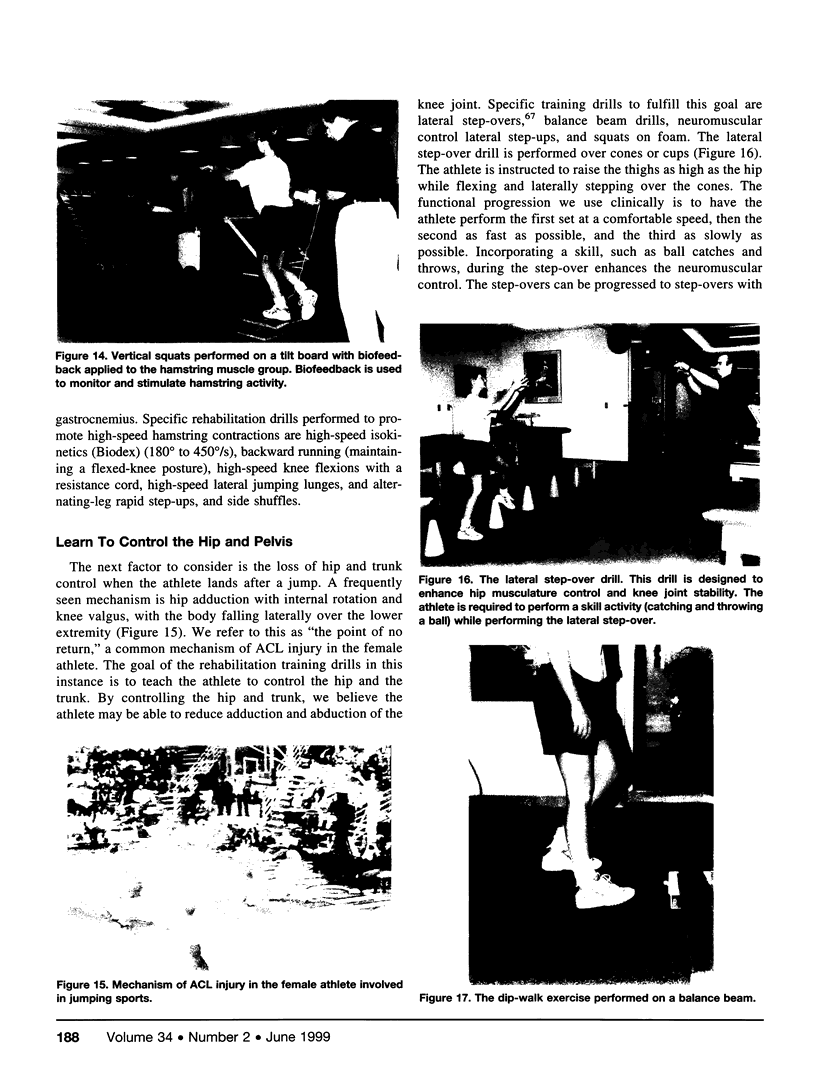
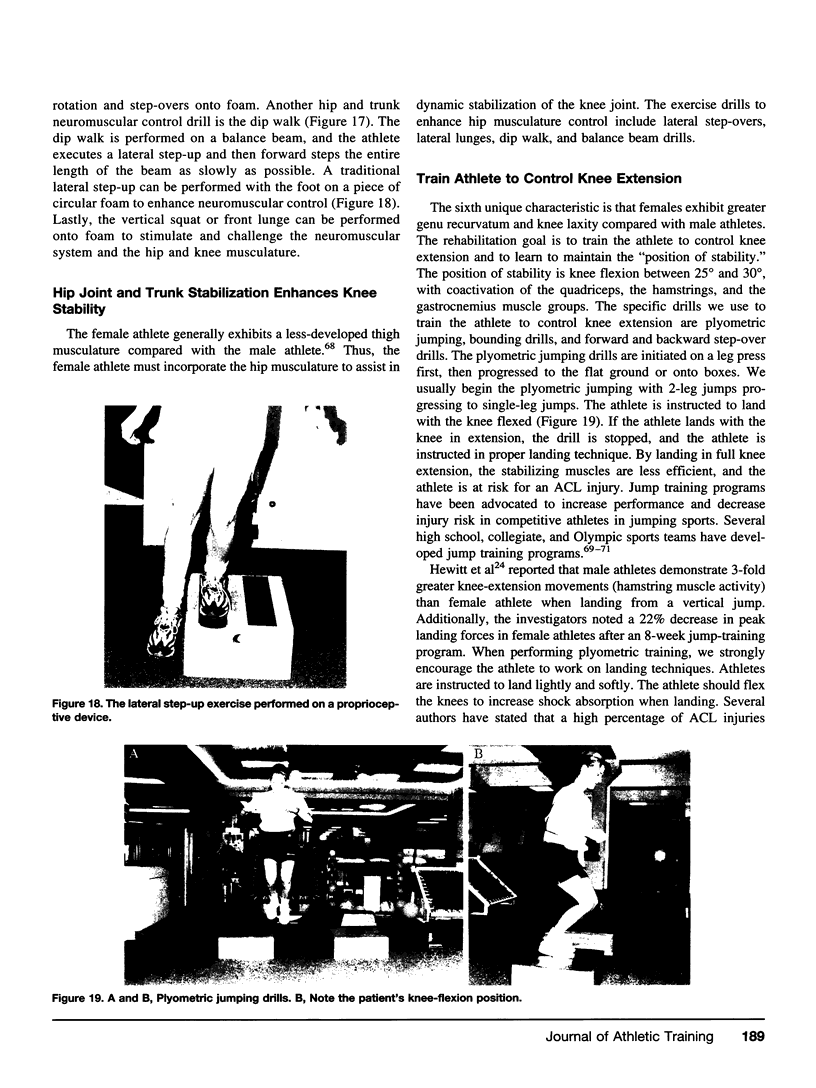
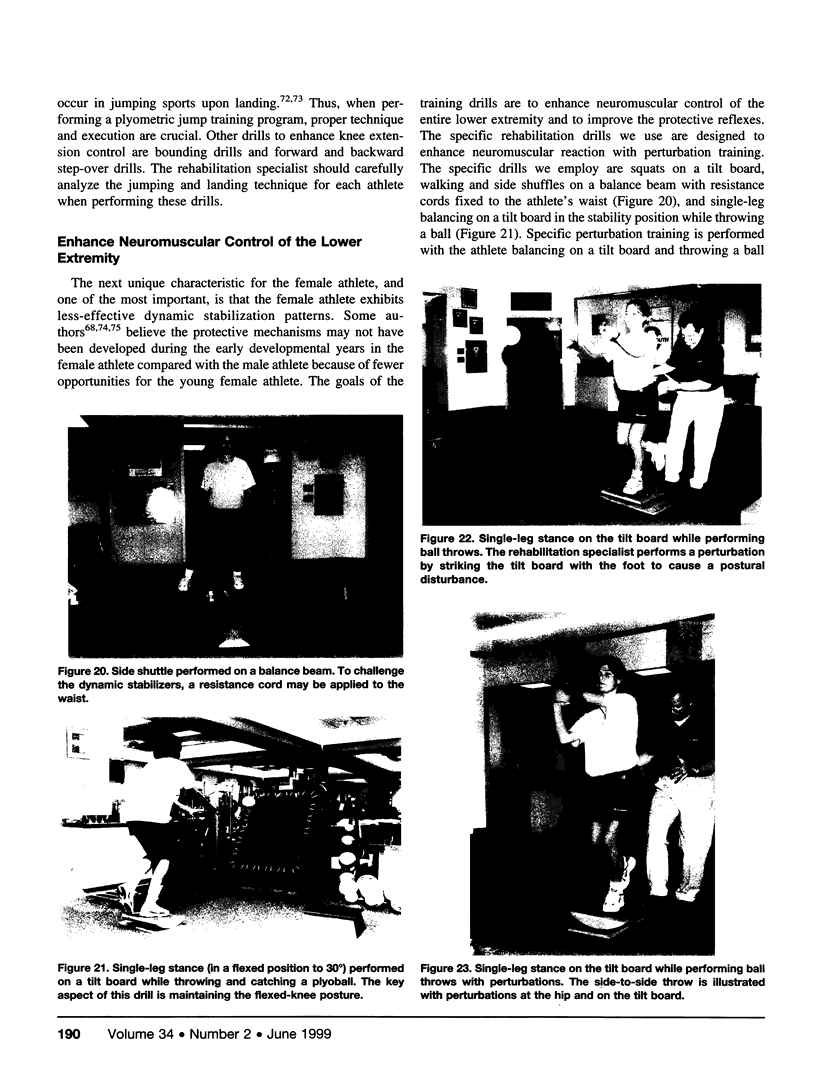
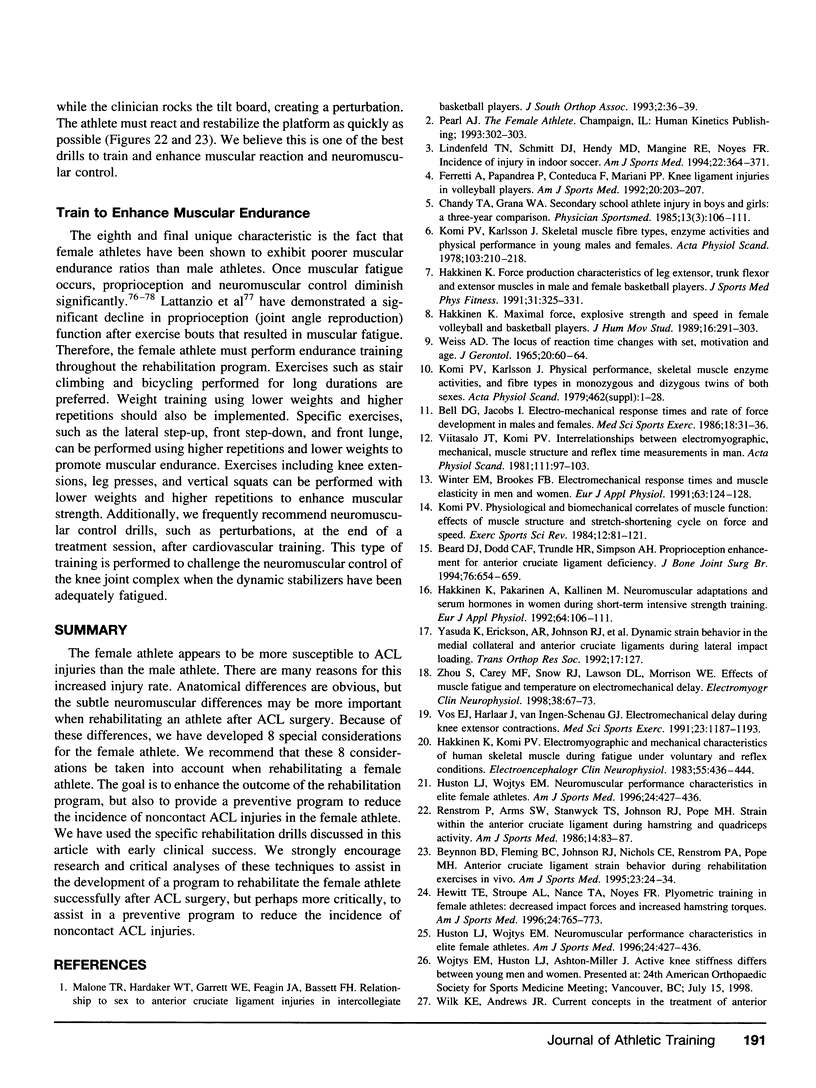
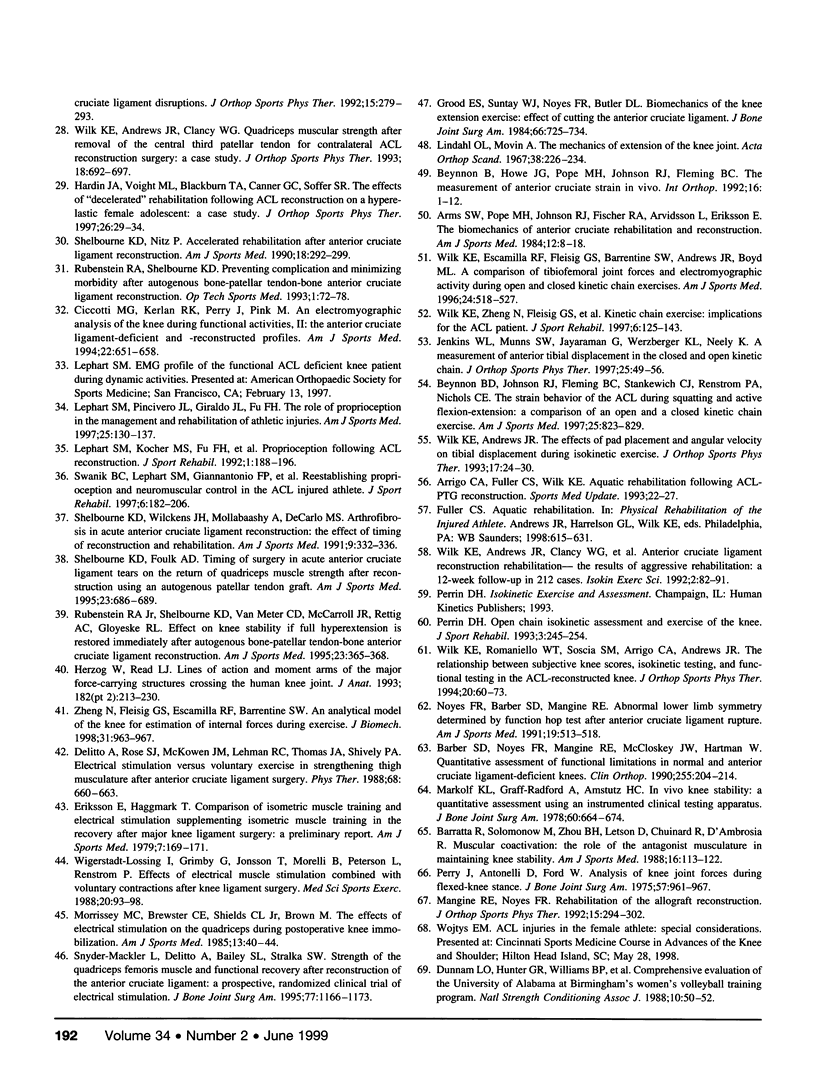
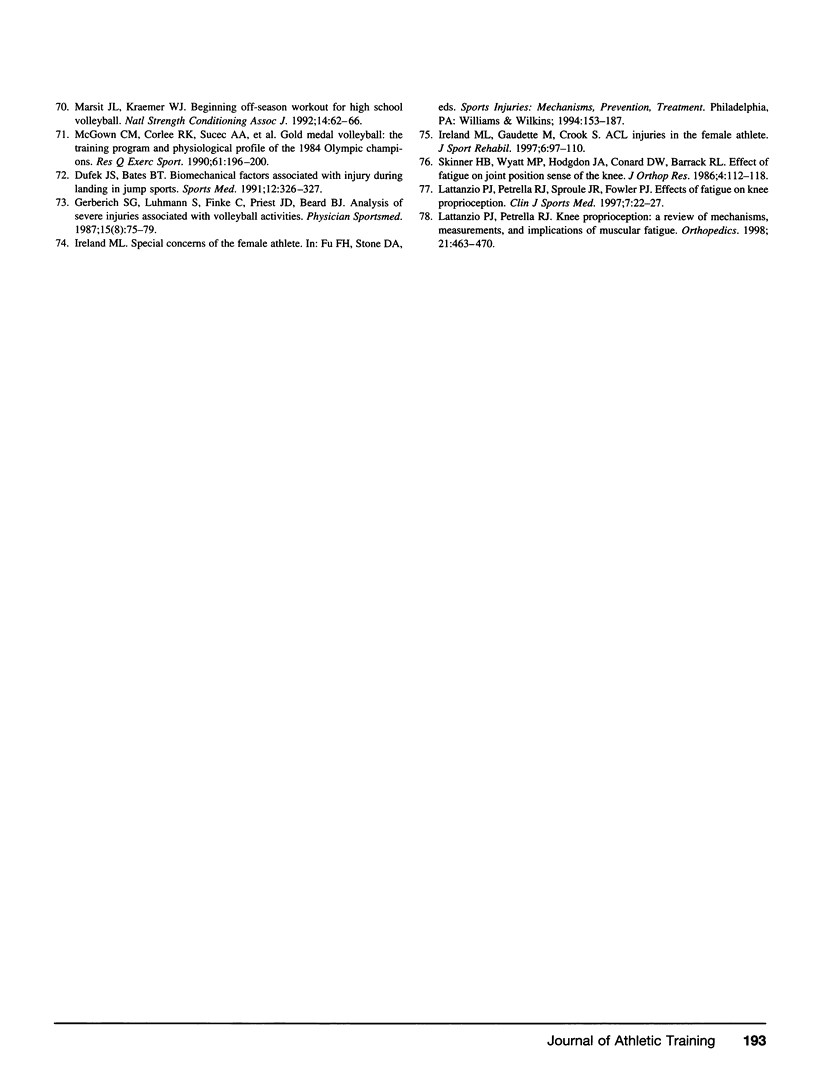
Images in this article
Selected References
These references are in PubMed. This may not be the complete list of references from this article.
- Arms S. W., Pope M. H., Johnson R. J., Fischer R. A., Arvidsson I., Eriksson E. The biomechanics of anterior cruciate ligament rehabilitation and reconstruction. Am J Sports Med. 1984 Jan-Feb;12(1):8–18. doi: 10.1177/036354658401200102. [DOI] [PubMed] [Google Scholar]
- Baratta R., Solomonow M., Zhou B. H., Letson D., Chuinard R., D'Ambrosia R. Muscular coactivation. The role of the antagonist musculature in maintaining knee stability. Am J Sports Med. 1988 Mar-Apr;16(2):113–122. doi: 10.1177/036354658801600205. [DOI] [PubMed] [Google Scholar]
- Barber S. D., Noyes F. R., Mangine R. E., McCloskey J. W., Hartman W. Quantitative assessment of functional limitations in normal and anterior cruciate ligament-deficient knees. Clin Orthop Relat Res. 1990 Jun;(255):204–214. [PubMed] [Google Scholar]
- Beard D. J., Dodd C. A., Trundle H. R., Simpson A. H. Proprioception enhancement for anterior cruciate ligament deficiency. A prospective randomised trial of two physiotherapy regimes. J Bone Joint Surg Br. 1994 Jul;76(4):654–659. [PubMed] [Google Scholar]
- Bell D. G., Jacobs I. Electro-mechanical response times and rate of force development in males and females. Med Sci Sports Exerc. 1986 Feb;18(1):31–36. [PubMed] [Google Scholar]
- Beynnon B. D., Fleming B. C., Johnson R. J., Nichols C. E., Renström P. A., Pope M. H. Anterior cruciate ligament strain behavior during rehabilitation exercises in vivo. Am J Sports Med. 1995 Jan-Feb;23(1):24–34. doi: 10.1177/036354659502300105. [DOI] [PubMed] [Google Scholar]
- Beynnon B. D., Johnson R. J., Fleming B. C., Stankewich C. J., Renström P. A., Nichols C. E. The strain behavior of the anterior cruciate ligament during squatting and active flexion-extension. A comparison of an open and a closed kinetic chain exercise. Am J Sports Med. 1997 Nov-Dec;25(6):823–829. doi: 10.1177/036354659702500616. [DOI] [PubMed] [Google Scholar]
- Beynnon B., Howe J. G., Pope M. H., Johnson R. J., Fleming B. C. The measurement of anterior cruciate ligament strain in vivo. Int Orthop. 1992;16(1):1–12. doi: 10.1007/BF00182976. [DOI] [PubMed] [Google Scholar]
- Ciccotti M. G., Kerlan R. K., Perry J., Pink M. An electromyographic analysis of the knee during functional activities. II. The anterior cruciate ligament-deficient and -reconstructed profiles. Am J Sports Med. 1994 Sep-Oct;22(5):651–658. doi: 10.1177/036354659402200513. [DOI] [PubMed] [Google Scholar]
- Delitto A., Rose S. J., McKowen J. M., Lehman R. C., Thomas J. A., Shively R. A. Electrical stimulation versus voluntary exercise in strengthening thigh musculature after anterior cruciate ligament surgery. Phys Ther. 1988 May;68(5):660–663. doi: 10.1093/ptj/68.5.660. [DOI] [PubMed] [Google Scholar]
- Dufek J. S., Bates B. T. Biomechanical factors associated with injury during landing in jump sports. Sports Med. 1991 Nov;12(5):326–337. doi: 10.2165/00007256-199112050-00005. [DOI] [PubMed] [Google Scholar]
- Eriksson E., Häggmark T. Comparison of isometric muscle training and electrical stimulation supplementing isometric muscle training in the recovery after major knee ligament surgery. A preliminary report. Am J Sports Med. 1979 May-Jun;7(3):169–171. doi: 10.1177/036354657900700305. [DOI] [PubMed] [Google Scholar]
- Ferretti A., Papandrea P., Conteduca F., Mariani P. P. Knee ligament injuries in volleyball players. Am J Sports Med. 1992 Mar-Apr;20(2):203–207. doi: 10.1177/036354659202000219. [DOI] [PubMed] [Google Scholar]
- Grood E. S., Suntay W. J., Noyes F. R., Butler D. L. Biomechanics of the knee-extension exercise. Effect of cutting the anterior cruciate ligament. J Bone Joint Surg Am. 1984 Jun;66(5):725–734. [PubMed] [Google Scholar]
- Hardin J. A., Voight M. L., Blackburn T. A., Canner G. C., Soffer S. R. The effects of "decelerated" rehabilitation following anterior cruciate ligament reconstruction on a hyperelastic female adolescent: a case study. J Orthop Sports Phys Ther. 1997 Jul;26(1):29–34. doi: 10.2519/jospt.1997.26.1.29. [DOI] [PubMed] [Google Scholar]
- Herzog W., Read L. J. Lines of action and moment arms of the major force-carrying structures crossing the human knee joint. J Anat. 1993 Apr;182(Pt 2):213–230. [PMC free article] [PubMed] [Google Scholar]
- Hewett T. E., Stroupe A. L., Nance T. A., Noyes F. R. Plyometric training in female athletes. Decreased impact forces and increased hamstring torques. Am J Sports Med. 1996 Nov-Dec;24(6):765–773. doi: 10.1177/036354659602400611. [DOI] [PubMed] [Google Scholar]
- Huston L. J., Wojtys E. M. Neuromuscular performance characteristics in elite female athletes. Am J Sports Med. 1996 Jul-Aug;24(4):427–436. doi: 10.1177/036354659602400405. [DOI] [PubMed] [Google Scholar]
- Huston L. J., Wojtys E. M. Neuromuscular performance characteristics in elite female athletes. Am J Sports Med. 1996 Jul-Aug;24(4):427–436. doi: 10.1177/036354659602400405. [DOI] [PubMed] [Google Scholar]
- Häkkinen K. Force production characteristics of leg extensor, trunk flexor and extensor muscles in male and female basketball players. J Sports Med Phys Fitness. 1991 Sep;31(3):325–331. [PubMed] [Google Scholar]
- Häkkinen K., Komi P. V. Electromyographic and mechanical characteristics of human skeletal muscle during fatigue under voluntary and reflex conditions. Electroencephalogr Clin Neurophysiol. 1983 Apr;55(4):436–444. doi: 10.1016/0013-4694(83)90132-3. [DOI] [PubMed] [Google Scholar]
- Häkkinen K., Pakarinen A., Kallinen M. Neuromuscular adaptations and serum hormones in women during short-term intensive strength training. Eur J Appl Physiol Occup Physiol. 1992;64(2):106–111. doi: 10.1007/BF00717946. [DOI] [PubMed] [Google Scholar]
- Jenkins W. L., Munns S. W., Jayaraman G., Wertzberger K. L., Neely K. A measurement of anterior tibial displacement in the closed and open kinetic chain. J Orthop Sports Phys Ther. 1997 Jan;25(1):49–56. doi: 10.2519/jospt.1997.25.1.49. [DOI] [PubMed] [Google Scholar]
- Komi P. V., Karlsson J. Physical performance, skeletal muscle enzyme activities, and fibre types in monozygous and dizygous twins of both sexes. Acta Physiol Scand Suppl. 1979;462:1–28. [PubMed] [Google Scholar]
- Komi P. V., Karlsson J. Skeletal muscle fibre types, enzyme activities and physical performance in young males and females. Acta Physiol Scand. 1978 Jun;103(2):210–218. doi: 10.1111/j.1748-1716.1978.tb06208.x. [DOI] [PubMed] [Google Scholar]
- Komi P. V. Physiological and biomechanical correlates of muscle function: effects of muscle structure and stretch-shortening cycle on force and speed. Exerc Sport Sci Rev. 1984;12:81–121. [PubMed] [Google Scholar]
- Lattanzio P. J., Petrella R. J. Knee proprioception: a review of mechanisms, measurements, and implications of muscular fatigue. Orthopedics. 1998 Apr;21(4):463–passim. doi: 10.3928/0147-7447-19980401-19. [DOI] [PubMed] [Google Scholar]
- Lattanzio P. J., Petrella R. J., Sproule J. R., Fowler P. J. Effects of fatigue on knee proprioception. Clin J Sport Med. 1997 Jan;7(1):22–27. doi: 10.1097/00042752-199701000-00005. [DOI] [PubMed] [Google Scholar]
- Lephart S. M., Pincivero D. M., Giraldo J. L., Fu F. H. The role of proprioception in the management and rehabilitation of athletic injuries. Am J Sports Med. 1997 Jan-Feb;25(1):130–137. doi: 10.1177/036354659702500126. [DOI] [PubMed] [Google Scholar]
- Lindahl O., Movin A. The mechanics of extension of the knee-joint. Acta Orthop Scand. 1967;38(2):226–234. doi: 10.3109/17453676708989636. [DOI] [PubMed] [Google Scholar]
- Lindenfeld T. N., Schmitt D. J., Hendy M. P., Mangine R. E., Noyes F. R. Incidence of injury in indoor soccer. Am J Sports Med. 1994 May-Jun;22(3):364–371. doi: 10.1177/036354659402200312. [DOI] [PubMed] [Google Scholar]
- Markolf K. L., Graff-Radford A., Amstutz H. C. In vivo knee stability. A quantitative assessment using an instrumented clinical testing apparatus. J Bone Joint Surg Am. 1978 Jul;60(5):664–674. [PubMed] [Google Scholar]
- McGown C. M., Conlee R. K., Sucec A. A., Buono M. J., Tamayo M., Phillips W., Frey M. A., Laubach L. L., Beal D. P. Gold medal volleyball: the training program and physiological profile of the 1984 Olympic champions. Res Q Exerc Sport. 1990 Jun;61(2):196–200. doi: 10.1080/02701367.1990.10608675. [DOI] [PubMed] [Google Scholar]
- Morrissey M. C., Brewster C. E., Shields C. L., Jr, Brown M. The effects of electrical stimulation on the quadriceps during postoperative knee immobilization. Am J Sports Med. 1985 Jan-Feb;13(1):40–45. doi: 10.1177/036354658501300107. [DOI] [PubMed] [Google Scholar]
- Noyes F. R., Barber S. D., Mangine R. E. Abnormal lower limb symmetry determined by function hop tests after anterior cruciate ligament rupture. Am J Sports Med. 1991 Sep-Oct;19(5):513–518. doi: 10.1177/036354659101900518. [DOI] [PubMed] [Google Scholar]
- Perry J., Antonelli D., Ford W. Analysis of knee-joint forces during flexed-knee stance. J Bone Joint Surg Am. 1975 Oct;57(7):961–967. [PubMed] [Google Scholar]
- Renström P., Arms S. W., Stanwyck T. S., Johnson R. J., Pope M. H. Strain within the anterior cruciate ligament during hamstring and quadriceps activity. Am J Sports Med. 1986 Jan-Feb;14(1):83–87. doi: 10.1177/036354658601400114. [DOI] [PubMed] [Google Scholar]
- Rubinstein R. A., Jr, Shelbourne K. D., VanMeter C. D., McCarroll J. R., Rettig A. C., Gloyeske R. L. Effect on knee stability if full hyperextension is restored immediately after autogenous bone-patellar tendon-bone anterior cruciate ligament reconstruction. Am J Sports Med. 1995 May-Jun;23(3):365–368. doi: 10.1177/036354659502300321. [DOI] [PubMed] [Google Scholar]
- Shelbourne K. D., Foulk D. A. Timing of surgery in acute anterior cruciate ligament tears on the return of quadriceps muscle strength after reconstruction using an autogenous patellar tendon graft. Am J Sports Med. 1995 Nov-Dec;23(6):686–689. doi: 10.1177/036354659502300609. [DOI] [PubMed] [Google Scholar]
- Shelbourne K. D., Nitz P. Accelerated rehabilitation after anterior cruciate ligament reconstruction. Am J Sports Med. 1990 May-Jun;18(3):292–299. doi: 10.1177/036354659001800313. [DOI] [PubMed] [Google Scholar]
- Shelbourne K. D., Wilckens J. H., Mollabashy A., DeCarlo M. Arthrofibrosis in acute anterior cruciate ligament reconstruction. The effect of timing of reconstruction and rehabilitation. Am J Sports Med. 1991 Jul-Aug;19(4):332–336. doi: 10.1177/036354659101900402. [DOI] [PubMed] [Google Scholar]
- Skinner H. B., Wyatt M. P., Hodgdon J. A., Conard D. W., Barrack R. L. Effect of fatigue on joint position sense of the knee. J Orthop Res. 1986;4(1):112–118. doi: 10.1002/jor.1100040115. [DOI] [PubMed] [Google Scholar]
- Snyder-Mackler L., Delitto A., Bailey S. L., Stralka S. W. Strength of the quadriceps femoris muscle and functional recovery after reconstruction of the anterior cruciate ligament. A prospective, randomized clinical trial of electrical stimulation. J Bone Joint Surg Am. 1995 Aug;77(8):1166–1173. doi: 10.2106/00004623-199508000-00004. [DOI] [PubMed] [Google Scholar]
- Viitasalo J. T., Komi P. V. Interrelationships between electromyographic, mechanical, muscle structure and reflex time measurements in man. Acta Physiol Scand. 1981 Jan;111(1):97–103. doi: 10.1111/j.1748-1716.1981.tb06710.x. [DOI] [PubMed] [Google Scholar]
- Vos E. J., Harlaar J., van Ingen Schenau G. J. Electromechanical delay during knee extensor contractions. Med Sci Sports Exerc. 1991 Oct;23(10):1187–1193. [PubMed] [Google Scholar]
- WEISS A. D. THE LOCUS OF REACTION TIME CHANGE WITH SET, MOTIVATION, AND AGE. J Gerontol. 1965 Jan;20:60–64. doi: 10.1093/geronj/20.1.60. [DOI] [PubMed] [Google Scholar]
- Wigerstad-Lossing I., Grimby G., Jonsson T., Morelli B., Peterson L., Renström P. Effects of electrical muscle stimulation combined with voluntary contractions after knee ligament surgery. Med Sci Sports Exerc. 1988 Feb;20(1):93–98. doi: 10.1249/00005768-198802000-00014. [DOI] [PubMed] [Google Scholar]
- Wilk K. E., Andrews J. R., Clancy W. G. Quadriceps muscular strength after removal of the central third patellar tendon for contralateral anterior cruciate ligament reconstruction surgery: a case study. J Orthop Sports Phys Ther. 1993 Dec;18(6):692–697. doi: 10.2519/jospt.1993.18.6.692. [DOI] [PubMed] [Google Scholar]
- Wilk K. E., Andrews J. R. The effects of pad placement and angular velocity on tibial displacement during isokinetic exercise. J Orthop Sports Phys Ther. 1993 Jan;17(1):24–30. doi: 10.2519/jospt.1993.17.1.24. [DOI] [PubMed] [Google Scholar]
- Wilk K. E., Escamilla R. F., Fleisig G. S., Barrentine S. W., Andrews J. R., Boyd M. L. A comparison of tibiofemoral joint forces and electromyographic activity during open and closed kinetic chain exercises. Am J Sports Med. 1996 Jul-Aug;24(4):518–527. doi: 10.1177/036354659602400418. [DOI] [PubMed] [Google Scholar]
- Wilk K. E., Romaniello W. T., Soscia S. M., Arrigo C. A., Andrews J. R. The relationship between subjective knee scores, isokinetic testing, and functional testing in the ACL-reconstructed knee. J Orthop Sports Phys Ther. 1994 Aug;20(2):60–73. doi: 10.2519/jospt.1994.20.2.60. [DOI] [PubMed] [Google Scholar]
- Winter E. M., Brookes F. B. Electromechanical response times and muscle elasticity in men and women. Eur J Appl Physiol Occup Physiol. 1991;63(2):124–128. doi: 10.1007/BF00235181. [DOI] [PubMed] [Google Scholar]
- Zheng N., Fleisig G. S., Escamilla R. F., Barrentine S. W. An analytical model of the knee for estimation of internal forces during exercise. J Biomech. 1998 Oct;31(10):963–967. doi: 10.1016/s0021-9290(98)00056-6. [DOI] [PubMed] [Google Scholar]
- Zhou S., Carey M. F., Snow R. J., Lawson D. L., Morrison W. E. Effects of muscle fatigue and temperature on electromechanical delay. Electromyogr Clin Neurophysiol. 1998 Mar;38(2):67–73. [PubMed] [Google Scholar]





